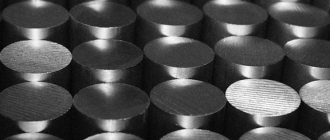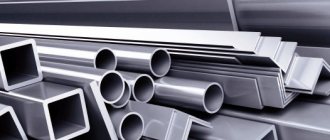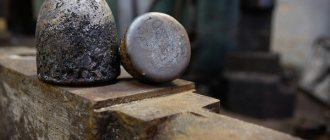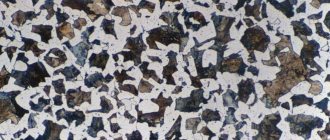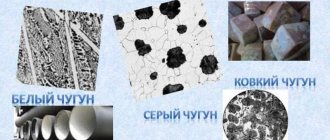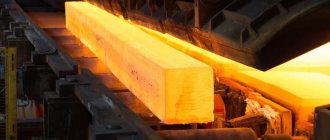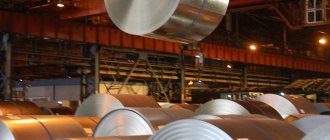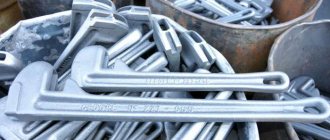Intergranular corrosion in austenitic stainless steels
The tendency of steel to intergranular corrosion manifests itself as a result of the precipitation of carbide phases. Therefore, when assessing the corrosion properties of steel, the most important factor is the thermokinetic parameters of the formation of carbides in it.
The susceptibility to intergranular corrosion of hardened steel type 18-10 is determined, first of all, by the concentration of carbon in the solid solution. An increase in carbon content expands the temperature range of steel's susceptibility to intergranular corrosion.
Steel type 18-10, when held in the range of 750-800 ºС, becomes prone to intergranular corrosion:
- with a carbon content of 0.084% - already within 1 minute;
- with a carbon content of 0.054% - within 10 minutes;
- at a carbon content of 0.021 5 – after more than 100 minutes.
As the carbon content decreases, the temperature simultaneously decreases, which corresponds to the minimum duration of isothermal exposure before the onset of intergranular corrosion.
Strength characteristics of stainless steel
Products made of stainless steel, similar to products made of carbon steel, are characterized by their definition through the so-called strength classes and hardness classes. Strength regulation for stainless steel fasteners is carried out in accordance with the international standard norm ISO 3506 (GOST R ISO 3506 in the Russian Federation).
Strength characteristics of stainless bolts, screws and studs
| steel grade | Strength class | Proof of yield, MPa | Tensile strength, MPa |
| from A1 to A5 | 50 | 210 | 500 |
| 70 | 450 | 700 | |
| 80 | 600 | 800 | |
| 60 | 410 | 600 |
Markings applied to products allow you to quickly determine the material and strength class.
Strength characteristics of stainless steel nuts
| steel grade | Strength class | Test load, MPa | ||
| Nuts | Low nuts | Nuts | Low nuts | |
| from A1 to A5 | 50 | 025 | 500 | 250 |
| 70 | 035 | 700 | 350 | |
| 80 | 040 | 800 | 400 | |
The low nut category includes nut models with heights ranging from 0.5D to 0.8D (with the first value included in the range and the second not), where D is the thread diameter of the nut. Regular nuts are defined as nuts with a height of 0.8D (inclusive).
In the tabular data, the test load is defined as a safe load, the removal of which does not lead to the formation of residual deformation at the nut. Low nuts have a lower value of this parameter compared to regular nuts.
The production of markings for the strength class and grade of stainless steel is carried out by analogy with bolts made of stainless materials. We can also talk about marking the materials of nuts in an alternative version, which involves making a cut (grooves) on the edges located on the sides. A2 is one row of grooves, A4 is two rows.
Strength characteristics of stainless steel set screws
In the indications of the strength characteristics of mounting screws made of stainless steel, the concept of strength class cannot be used. The main mechanical parameter is the hardness class. It is not necessary to mark the set screws, due to the lack of the necessary surface area for marking in the most common cases. Recognizing the brand and hardness class without the required documentation will be an extremely difficult task.
| Hardness scale | Hardness class | |
| 12H | 21H | |
| Units of hardness | ||
| Vickers HV | from 125 to 209 | not less than 210 |
| According to Brinell NV | from 123 to 213 | at least 214 |
| According to Rockwell HRB | from 70 to 95 | no less than 96 |
Stabilization of steel with titanium and niobium
When titanium and niobium, which promote the formation of carbides, are introduced into chromium-nickel steel type 18-10, the conditions for the precipitation of carbide phases change. At relatively low temperatures of 450-700 ºС, carbides of the Cr23C6 type are predominantly released, which give rise to a tendency to intergranular corrosion. At temperatures above 700 ºС, special carbides such as TiC or NbC are predominantly released. When only special carbides are isolated, there is no tendency to intergranular corrosion.
Decoding stainless steel grades
In order to choose the right grade of corrosion-resistant steel for certain purposes, it is most convenient to use special reference books. They provide information about all possible designation options for such alloys in different countries of the world. Among the huge variety of brands, we can highlight those that are most widespread among specialists in many countries around the world. These include the following grades of stainless steels with an austenitic structure.
- 10Х13Н17М3Т, 10Х13Н17М2Т: these grades are distinguished by, in addition to exceptional corrosion and thermal resistance, a good ability to form welded joints. Thanks to these qualities, products made from alloys of these brands can be successfully operated at elevated temperatures and come into contact even with very aggressive environments. The constituent elements of such alloys, which determine their unique characteristics, are: chromium (16-18%), molybdenum (2-3%), nickel (12-14%), carbon (0.1%), silicon (0. 8%), copper (0.3%), titanium (0.7%), manganese (2%), sulfur (0.02%), phosphorus (0.035%). In other countries, these brands are designated differently, in particular: in China - OCr18Ni12Mo2Ti, in Japan - SUS316Ti, in the USA - 316Ti, in France - Z6CNDT17-12.
- 08Х18Н10, 08Х18Н9: these steel grades are used for the production of pipes of various sections, elements of furnace equipment, and at chemical industry enterprises. The composition of such steels includes: chromium (17-19%), titanium (0.5%), nickel (8-10%), carbon (0.8%).
Stainless steel ducts
- 10Х23Н18: stainless steels of this grade belong to the heat-resistant category. When using them, be aware that they may become brittle when tempered. The composition of steels of this grade includes: chromium (22-25%), nickel (17-20%), manganese (2%), silicon (1%).
- 08Х18Н10Т: stainless steel products of this brand are welded well even without preheating and do not lose their corrosion resistance even at high temperatures. The insufficiently high strength that steels of this grade are characterized by is easily improved by heat treatment, which is recommended by GOST 5632-72.
- 06ХН28МДТ: a unique grade of steel, welded structures from which can be successfully operated even in very aggressive environments. The composition of this grade of corrosion-resistant steel includes: chromium (22-25%), nickel (26-29%), copper (2.5-3.5%).
- 12Х18Н10Т: products made from this grade of steel, characterized by high thermal stability and exceptional impact toughness, are mainly used in oil refining enterprises, in the chemical, pulp and paper industries, as well as in construction.
Correspondence table of the main grades of stainless steels and chemical composition
Stainless steel grades with a martensitic structure include: 40Х13, 20Х13, 12Х13, 30Х13. Products made from these grades of stainless steel cannot be joined by welding; they are mainly used to make cutting and measuring tools and spring elements. The great advantages of such products are the almost complete absence of internal defects (flocks) in them; moreover, they do not become more fragile after tempering.
Corrosion-resistant steels with a ferritic structure include: 08Х17, 08Х18Т1, 08Х13. It is not recommended to manufacture parts from these grades of steel that will experience significant shock loads and operate at low temperatures.
In order to understand the qualitative and quantitative composition of stainless steel, it is enough to decipher its brand. The algorithm for this decryption is quite simple:
- using the first number in the steel grade, the quantitative content of the main element after iron is determined - carbon (calculated in hundredths of a percent);
- The content of other elements in the steel (calculated in whole percentages) is determined by the numbers behind the letters by which such elements are designated (X - chromium, H - nickel, M - molybdenum, etc.).
A wide range of stainless steel grades allows you to find the best option for yourself. It should be borne in mind that certain types of stainless steel can be interchanged within certain limits. If you encounter difficulties when choosing steel, you need to contact technical consultants of specialized companies.
Nitrogen in austenitic stainless steels
Nitrogen, like carbon, has variable solubility in austenite. Nitrogen can form independent nitride phases during cooling and isothermal exposure or be part of carbides, replacing carbon in them. The effect of nitrogen on the susceptibility to intergranular corrosion of chromium-nickel austenitic steels is much weaker than that of carbon, and begins to appear only when its content is more than 0.10-0.15%. At the same time, the introduction of nitrogen increases the strength of chromium-nickel austenitic steel. Therefore, in practice, small additions of nitrogen are used in these steels.
Cold-resistant austenitic steels
Chromium-nickel austenitic steels
. Chromium-nickel austenitic steels containing 17-25% Cr and 8-25% Ni are widely used in low-temperature technology (cryogenic technology). Chromium-nickel austenitic steels retain high ductility and toughness over a wide temperature range, and also combine corrosion resistance with good technological properties.
The disadvantages of these austenitic steels include low strength at room temperature, especially at the yield point, as well as a relatively high cost due to the high content of expensive nickel.
Note: Austenitic economically alloyed cast iron for the manufacture of machine parts operating without changing dimensions in aggressive environments at temperatures down to -60°: see Niresist.
Cold-resistant austenitic steels also include chromium-manganese steels
(austenitic steels in which nickel is completely or partially replaced by manganese);
stable austenitic chromium-nickel-manganese steels with nitrogen
(austenitic steels simultaneously alloyed with chromium, nickel and manganese) and
metastable austenitic steels
.
Author: Kornienko A.E. (ICM)
Lit.:
- Gulyaev A.P. Metallurgy. – M.: Metallurgy, 1977. – UDC669.0 (075.8)
- Ivanov V.N. Dictionary-reference book for foundry production. – M.: Mechanical Engineering, 1990. – 384 p.: ill. ISBN 5-217-00241-1
- Solntsev Yu.P., Pryakhin E.I., Voytkun F. Materials science: Textbook for universities. – M.: MISIS, 1999. – 600 p. – UDC 669.017
Competition “Me and my profession: metallurgist, foundry technologist.” Find out, participate >>>
Effect of chromium content
With increasing chromium concentration, the solubility of carbon in chromium-nickel austenite decreases, which facilitates the precipitation of the carbide phase in it. This, in particular, is confirmed by a decrease in the impact toughness of steel with an increase in chromium content, which is associated with the formation of a carbide network along the grain boundaries.
At the same time, an increase in the concentration of chromium in austenite leads to a significant decrease in the susceptibility of steel to intergranular corrosion. This is explained by the fact that chromium significantly increases the corrosion resistance of steel. A higher concentration of chromium in steel results in a lower degree of depletion of grain boundaries when carbides are precipitated there.
Alloys resistant to corrosion and temperature changes
A wide range of additives allows you to create special steels that will be used for the manufacture of structural components and will work in cryogenic, high-temperature and corrosive conditions. Therefore, compositions are divided into three types:
- Heat-resistant and heat-resistant.
- Corrosion resistant.
- Resistant to low temperatures.
Heat-resistant alloys are not destroyed by chemicals in aggressive environments and can be used at temperatures up to +1150 degrees. They are made from:
- Elements of gas pipelines;
- Furnace fittings;
- Heating components.
Heat-resistant grades can resist stress at elevated temperatures for a long time without losing high mechanical characteristics. When alloying, molybdenum and tungsten are used (up to 7% can be allocated for each addition). Boron is used to grind grains in small quantities.
Austenitic stainless steels (resistant to corrosion) are characterized by a low content of carbon (no more than 0.12%), nickel (8−30%), chromium (up to 18%). Heat treatment is carried out (tempering, hardening, annealing). It is important for stainless steel products, because it makes it possible to hold up well in a variety of aggressive environments - acidic, gas, alkaline, liquid metal at temperatures of 20 degrees and above.
Cold-resistant austenitic compositions contain 8–25% nickel and 17–25% chromium. They are used in cryogenic units, but the cost of production increases significantly, so they are used very limitedly.
Delta Ferrite in Chromium Molybdenum Austenitic Steel
The presence of delta ferrite in the structure of austenitic chromium-nickel steel type 18-10 has a negative effect on its manufacturability during hot plastic deformation - rolling, piercing, forging, stamping.
The amount of ferrite in steel is strictly limited by the ratio of chromium and nickel in it, as well as by technological means. The group of steels most prone to the formation of delta ferrite is the X18N9T type (see also Stainless steels). When these steels are heated to 1200 ºС, the structure can contain up to 40-45% delta ferrite. The most stable are steels of the X18N11 and X18N12 types, which, when heated at high temperatures, retain an almost purely austenitic structure.
Welding of austenitic steels
A feature of welding austenitic steel is the absence of formation of space between the seams. Thanks to this, the structure of the material is not damaged and steel oxidation does not occur.
Welding must be done very delicately to avoid the formation of cold cracks. Before welding, it is strongly recommended to austenitize the material in order to achieve the plasticity of the metal, and heat treatment to strengthen the steel is carried out after the procedure. Preheating to 400 degrees also eliminates the danger of cold cracking.
Martensite in chromium-nickel austenitic steels
Within the grade composition in steels of the X18N10 type, chromium, nickel, carbon and nitrogen contribute to a decrease in the temperature of the martensitic transformation, which is caused by cooling or plastic deformation.
The influence of titanium and niobium can be twofold. Being in solid solution, both elements increase the stability of austenite with respect to martensitic transformation. If titanium and niobium are bound into carbonitrides, then they can slightly increase the temperature of the martensitic transformation. This happens because austenite in this case is depleted of carbon and nitrogen and becomes less stable. Carbon and nitrogen are strong austenite stabilizers.
Rules for marking corrosion-resistant steels
The designation consists of numbers and letters. The two-digit number at the beginning of the marking is the amount of carbon in hundredths of a percent. The following are letters characterizing certain alloying elements. After them are placed numbers equal to the percentage of alloying elements, rounded to the nearest whole number. If the percentage of the additive is in the range of 1-1.5, then the number is not placed after the letter. To symbolize alloying components in Russian regulatory documentation, the Russian alphabet is used:
- X – chromium;
- N – nickel;
- T – titanium;
- B – tungsten;
- G – manganese;
- D – copper;
- M – molybdenum.
Heat treatment of chromium-nickel austenitic steels
For chromium-nickel austenitic steels, two types of heat treatment are possible:
- hardening and
- stabilizing annealing.
Heat treatment parameters differ for unstabilized steels and steels stabilized with titanium or niobium.
Hardening is an effective means of preventing intergranular corrosion and giving steel an optimal combination of mechanical and corrosion properties.
Stabilizing annealing of hardened steel converts chromium carbides:
- to a state that is not dangerous for intergranular corrosion for non-stabilized steels;
- into special carbides for stabilized steels.
Products made of ausnitic steels
Semi-finished products in which steel is supplied are:
- Sheets 4-50 mm thick with guaranteed chemical composition and mechanical properties.
- Forgings. Due to the complex processing of these steels by welding, the production of some parts involves the production of almost finished products already at the casting stage. These are rotors, disks, turbines, engine pipes.
Austenite joining methods:
- Solder greatly limits the use of metal at temperatures above 250 °C;
- Welding is possible in a protective atmosphere (gas, flux), with subsequent heat treatment.
- Mechanical connection - bolts and other fasteners made of similar material.
Austenitic steels are one of the most expensive technical steels, the use of which is limited to a narrow specialization of equipment.
Above a certain content of manganese, nickel or some other elements, the γ-state exists as a stable state from room temperature to the melting point. Such highly alloyed iron alloys are called austenitic steels. Unlike other iron alloys, austenitic steels (and ferritic) do not undergo transformations upon heating and cooling [1]. Therefore, heat treatment is not used to strengthen austenitic steels.
Those. the austenite structure is obtained with a high content of an alloying element in the steel, expanding the region of the γ-phase (Ni, Mn, etc.), in this case the steel is called austenitic or austenitic class steel
[2].
In austenitic steels, chromium provides heat resistance and corrosion resistance, nickel stabilizes the austenitic structure and increases heat resistance, ductility and manufacturability, including at high and low temperatures, which explains the widespread use of austenitic steels as structural materials for a variety of conditions (aggressive environments, high temperatures, etc.).
Hardening of austenitic chromium-nickel steels
In steels without titanium and niobium additives, hardening means heating above the dissolution temperature of chromium carbides and fairly rapid cooling, which fixes a homogeneous gamma solution. The heating temperature for quenching increases with increasing carbon content. Therefore, low-carbon steels are hardened at lower temperatures than high-carbon steels. In general, the heating temperature range is from 900 to 1100 ºС.
The duration of exposure of steel at the hardening temperature is quite short. For example, for sheet material, the total heating and holding time when heated to 1000-1050 ºС is usually selected at the rate of 1-3 minutes per 1 mm of thickness.
Cooling from the quenching temperature must be rapid. For unstabilized steels with a carbon content of more than 0.03%, cooling in water is used. Steels with a lower carbon content and small cross-sections of the product are cooled in air.
for heat-resistant chromium steels
12XM, 12MX, 15XM, 15X5M, 15X5M-U:
- At design temperatures below 20 °C, the permissible stresses are taken to be the same as at 20 °C, subject to the permissible use of the material at a given temperature.
- For intermediate design wall temperatures, the permissible stress is determined by linear interpolation with rounding the results down to 0.5 MPa.
- The permissible stresses located below the horizontal line are valid for a service life of 105 hours. For a design service life of up to 2 * 105 hours, the permissible stress located below the horizontal line is multiplied by a factor of 0.85.
Stabilizing annealing of austenitic chromium-nickel steels
In unstabilized steels, annealing is carried out in the temperature range between the heating temperature for hardening and the maximum temperature for the manifestation of intergranular corrosion. The value of this interval primarily depends on the chromium content in the steel and increases with increasing its concentration.
In stabilized steels, annealing is carried out to transfer carbon from chromium carbides to special titanium and niobium carbides. In this case, the released chromium goes to increase the corrosion resistance of steel. The annealing temperature is usually 850-950 ºС.
Austenite: steel class and grade. Full review
Austenite, structural features, varieties
Austenite is a formation obtained in a solid solution of carbon intercalation into Y-iron (high-temperature modification of iron) with a face-centered cubic lattice (FCC). It is the arrangement of atoms in the crystal lattice that determines the characteristics of steel - resistance at low and high temperatures, lack of magnetic properties, chemical inertness, strength.
Due to various transformations of the austenitic structure of steel, the following types exist:
- Ferrite is a solid solution of carbon in a body-centered cubic lattice (BCC) of iron.
- Cooling of austenite to 730 °C leads to a eutectoid mixture of two phases - ferrite and cementite - into pearlite.
- A sharp decrease in temperature forms martensite.
Changes in the crystal lattice are provided for in advance, the decisive factors of the process are the holding time, programmed heating and cooling temperatures.
Austenitic alloys
Austenitic steel is a modification of iron with a high degree of alloying with the main components - chromium and nickel.
Chromium – content from 13% to 19% helps to cover the surface of the alloy with an oxide film, preventing corrosion.
Nickel is an element whose concentration of 9-12% stabilizes austenite in iron. The strength and ductility of steel increases.
Additional chemical additives are of two types:
- Ferritizers
- Silicon and manganese increase the strength of the austenite structure.
- Titanium and niobium are added to cold-resistant alloys.
- Austenizers
- Carbon - its task is to form carbides that give increased strength. The maximum amount in the composition is 10%.
- Nitrogen - replaces carbon when requiring a future product to be resistant to chemical and electrical influences.
- Boron – helps increase plasticity.
For alloying, additives are selected that correspond to the operational purpose and affect the physical, chemical, and technological properties of the alloy.
Austenitic steel grades
As a result of combinations and proportions of alloying impurities, steel grades with pronounced characteristics are obtained, allowing three main groups to be distinguished.
Corrosion resistant
These include: 08Х18Н10 (chrome and nickel), 07Х21Г7АН5 (with the inclusion of manganese), 03Х16Н16лЗ (with the addition of molybdenum), 15Х18Н12С4Т10 (increased silicon content).
Chromium-nickel stainless steels are characterized by high ductility during hot and cold deformation.
A low percentage of carbon content in the structure ensures the ability to resist corrosion when heated, and a chromium content of 13% and higher strengthens this feature in slightly aggressive environments, more than 17% is resistant in such aggressive environments as 50% nitric acid.
Heat resistant
This group includes: 08Х16Н9М2, 10Х14Н16Б, 10Х18Н12Т, 10Х14Н14В2БР.
The chromium content in the alloy of more than 12% forms a durable oxide film, providing scale and heat resistance, resistance to high temperatures (up to 1100 °C). The structure of steels is strengthened by alloying vanadium or molybdenum, tungsten, etc.
Alloys with this characteristic are in demand in the manufacture of aircraft turbines, parts of internal combustion engines of cars, when products come into contact with hot objects, steam, fire, etc.
Cold resistant
Typical representatives: 03X20N16AG6 and 07X13N4AG20.
The effect is created due to the increased nickel content of 25% and 17-19% chromium, which gives the alloys high viscosity and ductility, and increased resistance to corrosion. Alloys are indispensable in processes taking place in cryogenic mode.
These properties are preserved with a sharp decrease in temperature, but at room temperature the characteristics can change for the worse.
The use of cold-resistant alloys is limited due to the high cost of nickel.
Marking
The combination of letters and numbers characterizing the alloy is determined by the standards of GOST 5632-2014.
In the first place is a number indicating the percentage of carbon shares. Then the designation of additives with percentage content in the composition.
Note: small impurities are not displayed in the markings, but are necessarily listed in the technical data sheet of the alloy.
Example: 15Х18Н12С4Т10 – 0.15% carbon, 18% chromium, 12% nickel, 4% silicon, 10% titanium
Application
Products made of austenitic stainless steel are used in mechanisms operating in aggressive environments, as well as in difficult temperature conditions.
Supplied in the form of semi-finished products:
- Sheets with thickness from 4 to 50 mm.
- Forgings are products of a given shape that are used as blanks for the production of a wide range of products.
The requirements for this class of steel are specified in several regulatory documents:
- GOST 5632 – general requirements.
- GOST 5949 – requirements for mechanical properties.
- GOST 7350, 5582, 4986 determine the list of rolled sheet grades.
- GOST 18143 – requirements for volumetric profiles (rod, wire).
- GOST 11068, 9940, 9941 contain technical conditions for the production of stainless pipes.
Austenitic alloys provide ample opportunities for organizing complex technological processes in the oil and chemical industries, the space industry, aircraft construction, medicine, radio and electrical engineering.
Resistance of austenitic chromium-nickel steels to acids
The ability to passivate provides chromium-nickel austenitic steels with fairly high resistance to nitric acid. Steels 12Х18Н10Т, 12Х18Н12Б and 02Х18Н11 have the first resistance rating:
- in 65% nitric acid at temperatures up to 85 ºС;
- in 80% nitric acid at temperatures up to 65 ºС;
- 100% sulfuric acid at temperatures up to 65 ºС;
- in mixtures of nitric and sulfuric acids: (25% + 70%) and 10% + 60%) at temperatures up to 70 ºС;
- in 40% phosphoric acid at 100 ºС.
Austenitic chromium-nickel steels also have high resistance to solutions of organic acids - acetic, citric and formic, as well as alkalis KOH and NaOH.
Heat-resistant and heat-resistant austenitic steels
Austenitic steels with fcc lattice have significantly higher heat resistance compared to steels with bcc lattice.
Heat-resistant austenitic steels
, used for the manufacture of furnace equipment parts, are characterized not only by high heat resistance (scale resistance), but also by high heat resistance.
Heat-resistant austenitic steels
include 20Х23Н18, 20Х25Н20С2, which have scale resistance up to 1100°C.
Heat-resistant austenitic steels
.
Rotors, disks, blades of gas turbines, and diesel engine valves operating at temperatures of 600-700°C are made from heat-resistant austenitic steels. Chromium-nickel austenitic steels are additionally alloyed with tungsten, molybdenum, vanadium, niobium, boron and other elements to increase heat resistance. Heat-resistant steels of the austenitic class
include steels 09Х14Н16Б, 09Х14Н19В2БР, 45Х14Н14В2М.
